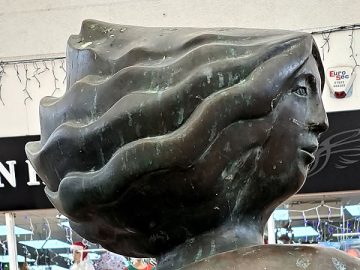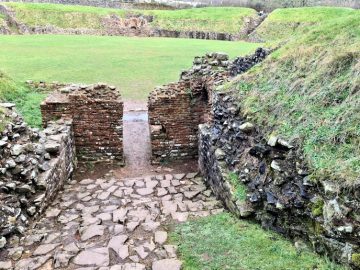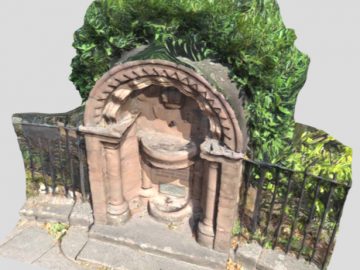As with most places around the world, the United Kingdom has many memorials to those who fell in war. Given the scale of suffering the two great wars (WWI and WWII) caused, it’s obviously unsurprising that many of those memorials commemorate them. But mostly those memorials are large structures, often more of a cenotaph than simply a memorial. Not so, however, for ‘A promise Honoured’, a First World War memorial to American troops, just outside the Great Hall in Winchester, southern England, which is small and accessible, as well as beautifully crafted. The sculptor states that the ‘viewer is free to sit on the bench and wonder where the soldier has gone‘ which should give you an idea of the power and interactive nature of this work of art. So when I visited Winchester I decided I couldn’t pass up the opportunity to make a quick 3D scan for later 3D printing and painting (in fact, the stone bench is part of the sculpture, but only the items carved over it are included here).
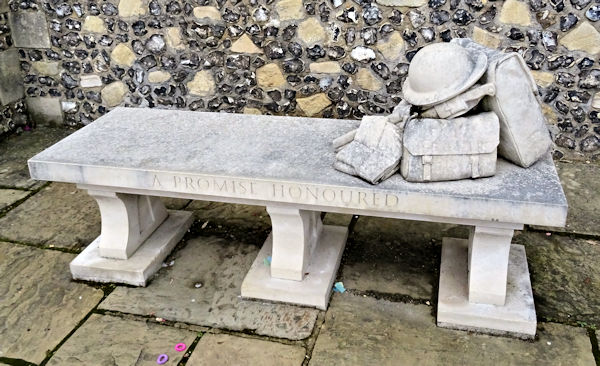
Quick summary of this 3D creation
Overview: A basic 3D scan of ‘A Promise Honoured’, a carved stone war memorial to World War One American troops in Winchester.
Location: Great Hall, Winchester, southern England, United Kingdom [map].
Date/era: Modern, 2014.
Software used: Sony 3DCreator Android app, Nomad Sculpt Android app, Meshmixer.
Intended use: 3D printing, either in resin or fused filament, the latter requiring very minimal support material.
Nearby: Westgate Museum Gargoyle sculpt.
The sculpture was created by Simon Smith Stone Carving and you can find out more about this work on their website by clicking here. Or, of course, you could visit Winchester to have a better look and experience it for yourself. According to the Simon Smith website ‘This memorial to the troops who passed through Winchester during the First World War is situated outside the Great Hall, in Castle Yard. It honours a promise made by the Mayor of Winchester in 1919 to commemorate the American soldiers billeted on the hills around Winchester. The memorial depicts a soldier’s kit left on a railway bench. The viewer is free to sit on the bench and wonder where the soldier has gone. It is designed and carved to honour the millions of troops who passed through Winchester. The memorial was unveiled by HRH Duke of Gloucester on 23rd June 2014.‘.
The scan was made with the Sony 3DCreator app on an Xperia XZ2 phone, which did an excellent job of the scanning, mostly only losing detail at such areas as around the buttons and bag flaps. The 3D scan was then imported into the Nomad Sculpt Android app where it was properly oriented, poorly scanned areas tidied, and edges sharpened using the crease tool with a small radius. Despite being intended as a 3D sculpting application, Nomad Sculpt has proven an excellent tool for processing and tidying up 3DCreator scans, as it has many tools for trimming, sculpting and smoothing, as well as a gizmo tool to help you translate, scale and rotate. It was used on a Samsung Galaxy Tab S6 Lite Android tablet as it has a pen/stylus that works very well with the pressure sensitivity feature of Nomad Sculpt, allowing easy and sensitive adjustments to be made.
The model was then post-processed using Meshmixer to remesh to a sensible file size. That was very important as the need to use a high polygon count in Nomad Sculpt, in order to carve out fine details and sharp edges, results in a large file size. That may not seem too important for 3D printing, but a smaller file size loads faster in the Sketchfab viewer, and also allows for quicker downloads of 3D model files to print. And, after sharpening edges in Nomad Sculpt, there was little loss of fine details after remeshing, which was helped by using the Meshmixer sharp edge preserving setting. You can see the finished model on Sketchfab below (click the play button to load the model and view it in 3D).
The small painted print in the photo below was then made using a Monoprice Mini SLA printer with Elegoo water washable resin. As I’ve found that water-based UV resin can sometimes cause some softening of sharp features, I was quite pleased by the results: even the edges around the helmet rim came out almost as good as in the original digital version. The larger one, on the right of the photo, was printed in Flashforge PLA, on one of their Adventurer 3C printers with no support material apart from a tiny bit under one of the bags. I wanted to see how it would print in fused-filament, as compared to resin, and I think it turned out very well indeed. In fact, unless you want a very detailed, and quite small, 3D print I think fused-filament printing would be good enough for most purposes. If you want to try 3D printing it yourself, click here to go to the MyMiniFactory page to download it.
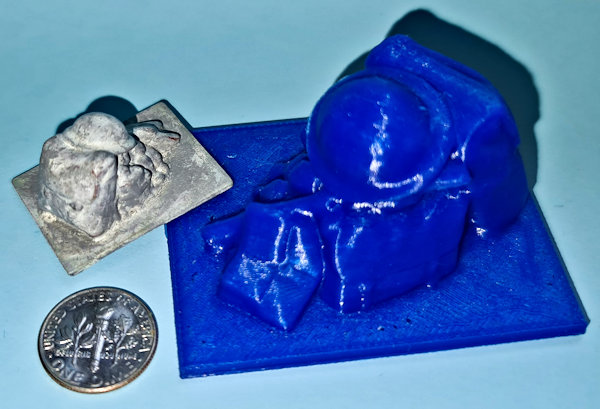
I painted the small resin version using The Army Painter paints, over a coat of their brush on primer to help smooth the surface and increase paint adhesion. I started with a dark grey colour, then added washes in lighter greys made using The Army Painter wash medium. I find their wash medium excellent for this kind of painting, as it is slightly viscous, and so less likely to run. I also did a bit of dry brushing around the creases to try to add a bit of depth, although I consciously avoided trying for dark shadows as I think that would have been a bit overpowering on such a small model. Then, a couple of coats of Citadel Technical Stormshield clear varnish were added to reduce glossiness. And overall I was quite happy with the result.
So finally, in case you’d like to use the methods in this project for your own work, let’s recap on what was involved:
- The Sony 3DCreator Android app was used to create a basic 3D scan on a smartphone, which provided a good representation albeit with some softening of sharp details.
- The scan was post-processed in Nomad Sculpt on an Android tablet, to correctly orient it, cut away excess material, smooth poorly scanned areas, and restore sharp edges using the crease tool.
- On a PC Meshmixer was used to solidify/remesh the model, to achieve a much smaller file size with minimal loss of detail.
- The finished 3D model was then test printed in resin and PLA, and found to print to an acceptable quality with both material types.
- Despite the detail in the final model, resin printing wasn’t found to be the most appropriate method, as fused-filament printing with minimal support material also produced good results.
Please note that this scan is provided without any license for commercial use. It is intended simply as a souvenir you can have the fun of printing yourself that advertises this beautiful sculpture. And of course it is intended to be a motivation for you to visit beautiful Winchester yourself and, while looking around the Great Hall, sit down with this excellent war memorial and work of public art: click here to see the location in Google Maps.


